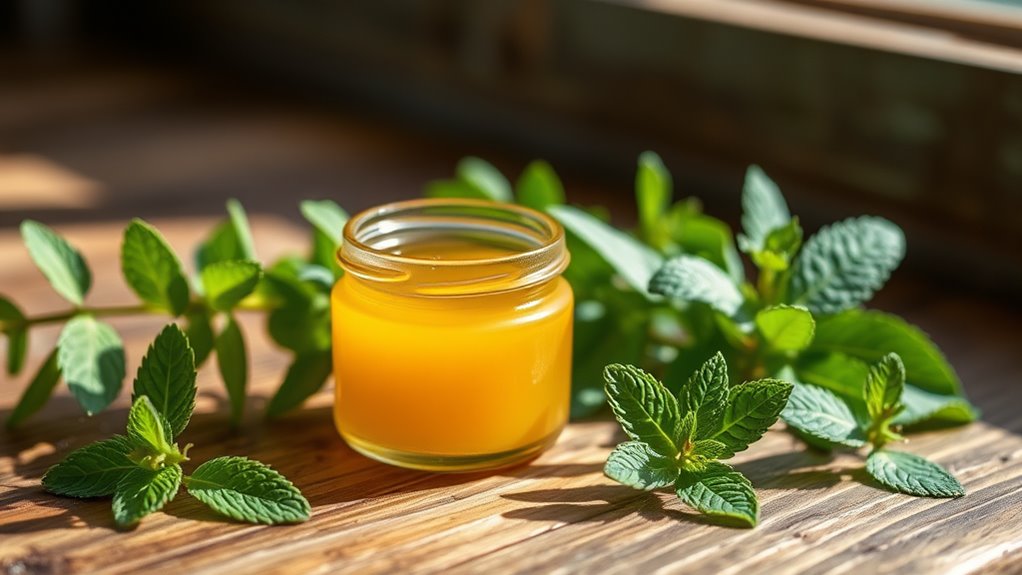Quick DIY Rub That Helps Loosen Chest Congestion
If you’re dealing with chest congestion, you might want to consider making a quick DIY rub that can provide relief. This homemade remedy combines soothing ingredients like eucalyptus and peppermint oils with a base of coconut oil and beeswax for thickness. It’s easy to whip up and can be a natural way to help ease your symptoms. Curious about how to make it and use it effectively? Let’s explore the details.
Key Takeaways
- Combine eucalyptus and peppermint oils with a base of coconut oil or shea butter for effective chest congestion relief.
- Melt beeswax into the mixture for a thicker, soothing consistency that enhances absorption.
- Apply the rub generously to the chest and neck using circular motions for maximum effect.
- Stay hydrated and use a humidifier to complement the rub and help thin mucus.
- Monitor symptoms and seek medical advice if you experience severe discomfort or persistent symptoms.
Ingredients Needed for the DIY Rub
To create an effective DIY rub for chest congestion, you’ll need a few key ingredients that are easy to find.
First, gather essential oils like eucalyptus and peppermint, known for their soothing properties.
Next, you’ll want coconut oil or shea butter as a base, providing moisture and helping the essential oils absorb into your skin.
You might also consider adding a bit of beeswax to give your natural chest rub a thicker consistency.
Finally, a touch of menthol crystals can enhance the cooling effect. These natural ingredients work synergistically to provide relief and promote healing.
With these ingredients, you’ll be ready to make a comforting rub that helps alleviate congestion.
Step-by-Step Instructions
Creating your DIY rub for chest congestion is a straightforward process that requires just a few steps.
First, gather all your ingredients and ensure they’re measured accurately.
Next, in a small bowl, combine your chosen oils and any additional ingredients, mixing well until you achieve a smooth consistency.
If you’re using beeswax, melt it gently before adding it to the mixture.
After everything is blended, pour the rub into a clean, airtight container.
Allow it to cool and solidify completely.
Label your container, and store it in a cool, dark place until you’re ready to use it for relief. Utilizing essential oils like eucalyptus and peppermint can enhance your rub’s effectiveness by providing natural soothing properties that may help alleviate congestion.
How to Apply the Chest Rub
Once your DIY chest rub is ready, applying it correctly can enhance its effectiveness in relieving congestion.
Follow these steps for optimal results:
- Warm it Up: Rub the mixture between your palms to warm it slightly before application.
- Target the Chest: Apply a generous amount directly to the chest area, using circular motions.
- Neck and Throat: Lightly massage some onto your neck and throat for additional relief.
- Clothing Consideration: Wear a loose shirt to avoid irritation and allow the rub to work effectively.
Using a chest rub can be beneficial because it may help reduce coughing symptoms by soothing the airways.
With these steps, you’ll maximize the benefits of your homemade chest rub!
Additional Tips for Relieving Chest Congestion
Staying hydrated’s key; drink plenty of fluids like water, herbal teas, or broths to help thin mucus.
Consider using a humidifier to add moisture to the air, which can soothe irritated airways.
Warm compresses on your chest can provide comfort and promote circulation.
You might also find relief with steam inhalation; just lean over a bowl of hot water with a towel over your head.
Lastly, try gentle chest percussion—lightly tapping your chest to help loosen mucus.
These methods can work in tandem with your DIY rub for better results. Additionally, steam therapy has been shown to be effective in relieving congestion, making it a popular choice among parents.
When to Seek Medical Advice
How do you know when it’s time to seek medical advice for chest congestion? It’s essential to pay attention to your symptoms.
Consider reaching out to a healthcare professional if you experience:
- Persistent chest pain or discomfort
- Difficulty breathing or wheezing
- Fever over 100.4°F (38°C) lasting more than three days
- Coughing up blood or green/yellow mucus
Don’t hesitate to consult a doctor if your symptoms worsen or don’t improve with home remedies. Additionally, effective home remedies can provide temporary relief, but they should not replace professional medical advice.
Early intervention can help prevent complications and ensure you receive the appropriate care for your condition.
Your health is worth it!




